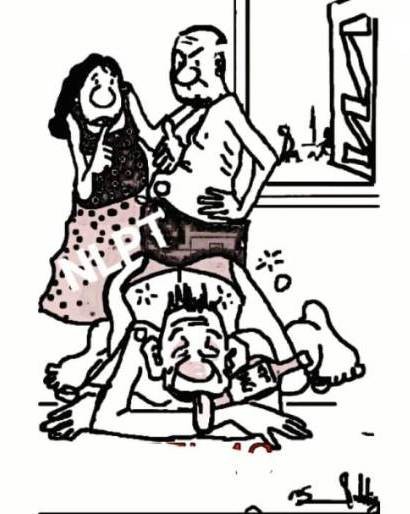I don't know which is doing more damage, the Act or the booze. (Illustration by Sandemo Ngully)

Imkong Walling
Dimapur | April 20
In the first of a three-part series, it was revealed that a sample of branded alcohol sold in Nagaland failed to meet quality parameter specified by the Food Safety and Standards (Alcoholic Beverages) Regulations, 2018.
The finding, though not officially made public by the government, was the outcome of an almost 4-year long plan of the Neiphiu Rio-led coalition government to revisit the NLTP Act.
It also produced an alcohol impact report submitted by the Health & Family Welfare (H&FW) Department to a government Committee constituted in November 2018 to “study issues related to the implementation of the Nagaland Total Liquor Prohibition Act, 1989.”
The Committee was initially headed by the Additional Chief Secretary and subsequently by the Chief Secretary. Its job was to “examine all aspect of health issues,” including alcohol consumption trend in the state and collating as well as comparing alcohol revenue data of other states.
The job of the H&FW was to report on the health concern, while the Food Safety Cell was directed to collect and analyse different brands of illicit alcohol found in the state. A separate team was assigned to study the “Excise system” in other states. The team went to Telangana, Mizoram and Assam.
In March 2019, the H&FW told the Committee that there was an increase in alcohol-induced ailments and casualty in the state, but, as per official papers, no data was presented.
There was a break in 2020 owing to the COVID-19 induced restrictions.
By mid-2021, other reports, as assigned, were submitted. In a July 2021 meeting, the Committee deemed the findings of the laboratory analyses of alcoholic beverages “a matter of great concern.” It was in this meeting, the H&FW was again asked to submit a report on the public health hazard. The decision to consult civil society organizations, including the tribal, church and students bodies, was taken in this meeting.
By all accounts, the government appeared confident and was targeting the 2022 Budget Session to pitch a proposal. As the date neared, it reportedly got cold feet, putting the brakes on the closely guarded 4 year-old plan. Electoral concerns vis-à-vis the 2023 Assembly polls likely weighed on the government to play safe, sources said.
Health concern report
The H&FW report on the public health concern was submitted in August 2021. The brief two-page report included a bit from the National Family Health Survey (2019-20), which said that 23.3 percent of male and 0.8 percent of the female population in Nagaland consume alcohol.
The part on the health impact was confined to data recorded in 2019 at two government hospitals, namely— NHAK, Kohima and District Hospital, Dimapur. It said that 5 percent of all deaths in the NHAK were attributed to alcohol abuse. Data from the Dimapur District Hospital stated that 30-40 percent of all admissions in 2019 were related to alcohol abuse. “Of the 196 alcohol related admission in the drug De-addiction Centre in Dimapur, 50 percent are of the 20-50 years (age) group,” it said, while adding that 38 percent and 82 percent of the total were married and employed, respectively.
Besides, it highlighted general statistics linked to alcohol abuse in India and globally. It said that 5.3 percent of all deaths and 5.1 percent of the global burden of disease and injury is attributable to alcohol, while referencing a causal relationship between harmful alcohol use and a range of behavioural disorders.
In 2005, it said that 17.4 percent of the estimated 62.5 million people using alcohol in India had “alcohol use disorder” and 20-30 percent of all hospital admissions were “due to alcohol related problems.” In 2010, 40 percent of all road accidents were attributed to inebriated driving. The prevalence rate of alcohol use has been estimated at 23-74 percent in males and 24-48 percent in females.
Safe limit
Incorporated in the report was a segment about “safe limit” of alcohol consumption. Again, there was no source citation. Nevertheless, it said that the par is set at 21 units per week in men and 14 units in women, with 1 unit approximated as 25ml (of whisky). By Indian alcohol retail standard, that is 525ml a week or “a half and 30ml short of a quarter.”
It stated, “No more than 3 units in one day, and to have at least two alcohol-free days a week. In the US or UK, one is allowed to drink and drive with less than 80mg per 100ml of blood. In India, however, the limit is set at .03 percent, which works to 30mg of alcohol per 100 ml of blood.”
Other sources, citing the National Sample Survey (NSS) of 2011-12, point to a relatively high alcohol consumption trend in Nagaland per capita. The ten years old NSS data, which was referenced in a news story published by The Morung Express in January 2019, Nagaland placed higher than liquor-legal Meghalaya, consumption-wise. To quote the news story, “The per capita consumption per week in Meghalaya was 123ml as compared to Nagaland’s 182ml per capita per week.” It pegged Mizoram’s (Prohibition era) alcohol consumption gauge at 31ml per capita per week.
(This is the second of a three-part series)






